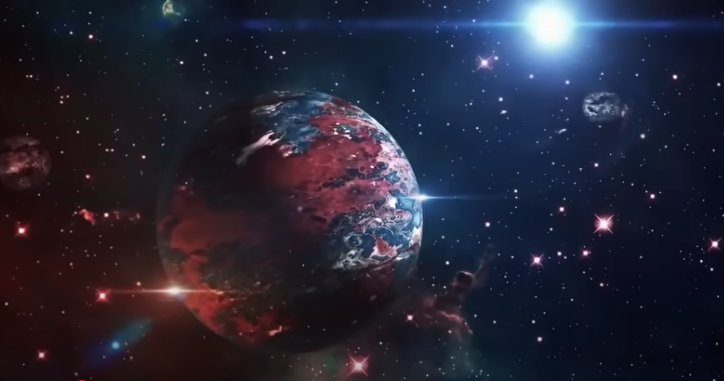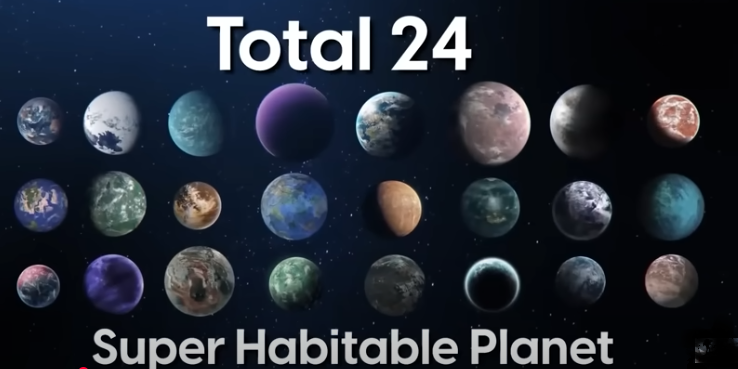Ideal Planets for life better than Earth | What are 24 Exoplanets?
OR Super Habitable Planets

Ideal Planets for life other than Earth: We have always been wondering that if we set foot on any other planet in the universe, then due to the high gravity, high temperature, high pressure and bad atmosphere, we will be destroyed within minutes. We will not be able to survive there. But what if I say that there are such planets in the universe whose environment will not destroy us, but your health will become so healthy that you will start feeling as if you have got super powers.
Recently scientists have found many such habitable planets which are many times better than Earth in all respects. Life can evolve very rapidly and for a very long time on these planets. So which are these planets? Earth is the only planet on which simple life forms to complex masses capable of living in any extreme environment have evolved and are still evolving. So, seeing all this, it is obvious that we consider Earth to be the only or a unique planet. But many researches say that there can be many other planets whose environment is more favorable than Earth’s environment. But because we are living on Earth and that is why instead of looking for a better planet, we are spending all our time searching for the mirror image of Earth. Which is totally wrong.
Who launched the mission to find super habitable planets on October 5, 2020? What criteria did they use to filter the planets, and how many super habitable planets did they find?
That is why on 5th October 2020, Washington State University and the Technical University of Berlin Gastro Biologist Dirk Shuls Maku started a new mission, through this mission he targeted such planets which were better than our earth in all respects and you won’t believe that he found such planets and that too not one or two but 24 super habitable planets. So basically Shuls Maku and his team decided to do a separate observation to find these planets and for this they made a list of criteria and if any planet was not following those criteria that means that planet was not super habitable. So this was a simple way how they were filtering the planet.
Also read; Existence of a 10th Dimension | Power of Aliens Being Visualized
What is required for any life to survive?
For the sake of understanding about Ideal Planets for life other than Earth, scientists made a list of criterion. Here are..
The first criterion
A suitable temperature, good atmosphere, water and a large land surface area. And keeping all these factors in mind, they decided the criteria out of which the most Ideal Planets for life other than Earth The first criterion was the age of the host star. Normally, when exoplanets are explored, the main focus of scientists is to find yellow dwarf stars, i.e. stars like the Sun. But this time, the team of Schools Makge targeted yellow dwarfs as well as orange dwarf stars, which are cooler, dimmer and less massive. The main advantage behind doing this was the life span of those stars. Actually, the life span of all the yellow dwarfs in the universe is only up to 10 billion years. And in comparison to those stars, orange dwarfs live twice as long, i.e. 20 to 50 billion years. And its simple meaning was that if any life evolves in this planetary system, then it can evolve for two or three times longer than the Earth.
Second criterion
Potentially, but that in no way means that stars always need more life. It should be older because the interior geothermal energy of the event planets cools down with time and loosens the magnetic field. Anyway, now let’s move on to the second criterion which is water. Well, as soon as we find a proper planetary system, the first thing to do is to measure the distance between that planet and its host stars. This will help us find out if that planet is in the habitable zone or not. So that we can find out what the percentage of water would be on that particular planet.
Third criterion
Now the third fact in the list of criteria was The Size and Mass of Planets. According to researchers, the mass and size of any planet can influence the evolution of life. Basically, their concept was very simple. The bigger the size, the bigger the habitable surface area. And not just this, the more the mass, the more the gravity and if more the gravity means potentially a thicker and more stable atmosphere but there is also one condition in which the planet’s mass is only one and a half or two times compared to the mass of the Earth. It should be bigger so that the interior of the planet will remain heated for a longer time and this hot interior will help in keeping the core molten and because of this the protective magnetic field will remain active around that planet for a longer time and then light might have a chance to arise and evolve.
Forth criterion
Now the next important criteria was temperature which is obvious because if the temperature of any planet is high, it means indirectly its pressure will also be high and surviving in extreme temperatures is like putting one’s hand in hot oil and that is why scientists focus on such plants whose average surface temperature is 5 degrees Celsius less or more than the surface temperature of the Earth. Well there is a reason behind this also because if I talk about the temperature of the tropical region of the Earth, then the microbes growing there mostly survive in these extreme temperatures.

Here is the detail of some of the Exoplanets and Celestial bodies
K 5715 P0
- One of two discovered super habitable planets.
- Scientists consider it better than Earth in terms of surface temperature and atmosphere.
- They are described as perfect for the evolution of life.
K55 4.01
- The second super habitable planet.
- Surface temperature: 27°C, ideal for human survival.
- Active movements of tectonic plates support a continuous nitrogen cycle.
- The nitrogen cycle helps:
- Production of amino acids, proteins and DNA.
- Support for a cleaner environment and faster ecosystem development.
Kea 571511
- Surface temperature: 2.4°C lower than Earth.
- Planet mass: Seven times that of Earth.
- Size is larger → larger land area.
- High gravity and stable atmosphere.
- Scientists estimate abundant water resources based on distance from host star.
LHS 1140
- Discovered on April 20, 2017 during the M Earth project using the transit method.
- The transit method involves observing changes in the brightness of red dwarfs.
- It has an iron-nickel core that covers 75% of the Earth’s mass as lava.
- Scientists have found 4% water below the core → possibility of an underground water world.
- Due to its mass, the greenhouse effect maintains a good balance of the atmosphere.
Luton B
- Discovered on March 17, 2017 using the radial velocity method.
- Radial velocity tracks the motions of stars to detect massive planets.
- Contains large amounts of: water, amino acids, Hydrocarbons
- Possibly influenced by advanced civilizations.
- Two messages were sent to this planet in October 2017 and 2018:
- A short musical composition.
- A scientific guide to its location in space.
Callisto (Jupiter’s moon – not an exoplanet, but a possible super-habitable celestial body)
- Once thought to be inactive and rocky.
- In 1990, it was discovered that a salty ocean lies beneath its icy surface.
- This ocean could soon be used for rocket propulsion.
- It has a distinctive atmosphere.
- It receives high radiation from Jupiter.
If radiation shielding is chosen, Callisto has:
- A great atmosphere
- Water
- Low gravity i.e. making it a strong candidate for future human colonization.